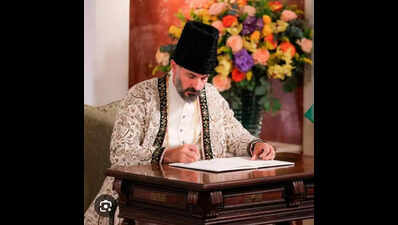- News
- City News
- mumbai News
- City’s Ismailis celebrate Aga Khan V’s rise
Trending
City’s Ismailis celebrate Aga Khan V’s rise
Prince Rahim Aga Khan V has ascended as the 50th hereditary Imam of Shia Ismaili Muslims following the death of his father, Prince Karim Al-Hussaini Aga Khan IV. The ceremony witnessed both mourning and celebration among Ismaili communities globally, highlighting the significance of the living, hereditary Imam in Ismaili tradition.
Days after the death of Prince Karim Al-Hussaini Aga Khan IV, the 49th hereditary Imam or spiritual leader of Shia Ismaili Muslims, his son Prince Rahim Aga Khan V ascended to the Ismaili Imamat. Accompanied by his family, the 50th hereditary Imam received leaders of the Ismaili community who pledged their allegiance to him at the global community's headquarters, Diwan of the Ismaili Imamat, in Lisbon, Portugal.
Hundreds of miles away, community members in Mumbai witnessed the ceremony livestreamed to their Jamatkhanas. "It was a moment of both sadness and joy. While the global Ismaili community mourned the passing of our 49th Imam, we also celebrated the ascension of His Highness Prince Rahim Aga Khan as the 50th hereditary Imam," says Sophia Premji, communications co-ordinator, Ismaili Council for India.
Mumbai is important to the Shia Ismailis for many reasons. It is here that the Ismaili community's National Council office is located. In Dongri, a historically important Jamatkhana called Darkhana, a heritage structure, stands as a testimony to the community's journey. For nearly a century, Mumbai remained the seat of Imamate.
Hasan Ali Shah married the then Shah of Iran, Fateh-Ali Shah Qajar's daughter, in 1817. The Shah of Iran bestowed the title Aga Khan (commanding chief) on him. Hasan Ali Shah, the Aga Khan I, emigrated to India in the 1840s and settled in Mumbai in 1848. The Aga Khan I's mausoleum is at Hasnabad in Mazgaon. The Ismaili Imamat remained headquartered in Mumbai until Sir Sultan Mahomed Shah, the Aga Khan III, moved it to Europe.
"The Ismailis are the second largest Shia Muslim community. The Ismailis and Ishnaashari or ‘Twelvers Shias' parted ways over the succession to the great, great grandson of Ali and Fatima, Imam Jafar al-Sadiq (died in 765)," says scholar Sameer Noorani, who graduated from London-based Aga Khan University.
The Ishnaasharis transferred their allegiance to al-Sadiq's youngest son Musa al-Kazim and after him, in lineal descent, to Muhammad al-Mahdi, their twelfth Imam. The Ishnaasharis are the largest Shia Muslim community.
"The Ismailis gave their allegiance to Imam Jafar al-Sadiq's eldest son Ismail, from whom they derive their name. Throughout their history, the Ismailis have been led by a living, hereditary Imam," adds Premji.
In the 11th century, the Ismaili community suffered a schism over the succession to Imam Mustansir Billah (d. 1094). One section of the community followed his youngest son al-Mustali. The Dawoodi Bohras are Mustaili sect of Shia Islam and believe that their Dai (spiritual head) is representative of the Imam who is in seclusion.
The other section gave its allegiance to Imam Mustansir Billah's eldest son Imam Nizar, from whom the Aga Khan, the present Imam of the Ismailis, traces his ancestry.
Unlike Sunnis, Shias believe that Hazrat Ali is the Prophet's successor. They cite an incident in 632 at a place called Ghadir Khumm when, while returning from his pilgrimage to Mecca, the Prophet, according to Shia belief, declared Ali as his successor. "Delivering the sermon at Ghadir, the Prophet said ‘to whosoever I am Mawla, Ali is also their Mawla.' The word Mawla is interpreted both as master and successor, and the day is celebrated as Eid-e-Ghadir by the Shias," says MLA Amin Patel, a member of the Shia Ismaili community.
However, the Sunnis believe that, after the death of the Prophet, his close companion Hazrat Abu Baqar Siddique succeeded him and became the first Caliph.
Stay updated with breaking news, weather updates, bank holidays and upcoming public holidays in march.
End of Article
FOLLOW US ON SOCIAL MEDIA







